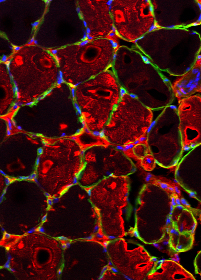Molecular Basis of Cardiac and Skeletal Myopathy and Cardiac Hypertrophy and Heart Failure
My lab primarily focuses on understanding the molecular basis of cardiomyopathy and heart failure, with a concurrent effort to develop potential therapies for these conditions.
Mutations in cytoskeletal proteins have been shown to play a critical role in the pathogenesis of human cardiac and skeletal myopathies. A major focus of the Chen lab is to understand mechanisms by which mutations in cytoskeletal proteins cause myopathy by utilizing genetically engineered mouse models, human induced pluripotent stem cells (iPSCs) from human patients, physiological measurements, and a range of molecular and cell biological techniques. Another major focus of the lab is the study of signaling pathways underlying cardiac hypertrophy and heart failure. Learn more about cardiomyopathies.
To perform force-generating contraction, and to accommodate repetitive changes in cell geometry that occur during each contraction, cardiac and skeletal myocytes have evolved an abundant and highly specialized cytoskeleton. Cytoskeletal components are classified as sarcomeric or extrasarcomeric. The extrasarcomeric network provides a link between adjacent myofibrils to the nuclear envelope and between myofibrils to the sarcolemma/t-tubule and to the extracellular matrix. The Chen lab studies a number of sarcomeric and extrasarcomeric proteins, including Z-disc proteins, intermediate filament proteins, nuclear envelope proteins, and proteins which link the sarcomere to the extracellular matrix. In this manner, the Chen lab is developing a comprehensive understanding of the complex cytoskeletal network required for optimal striated muscle function. Additionally, the role of several protein kinases and receptors in cardiac hypertrophy and heart failure is also being investigated. Learn more about our research focus.

Learn more about our research focus
We are interested in elucidating molecular mechanisms behind human muscle diseases using genetically engineered mouse models.
Page 'Breadcrumb' Navigation:
